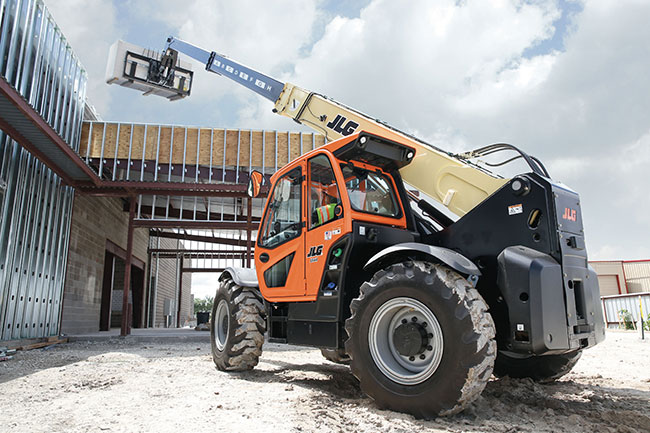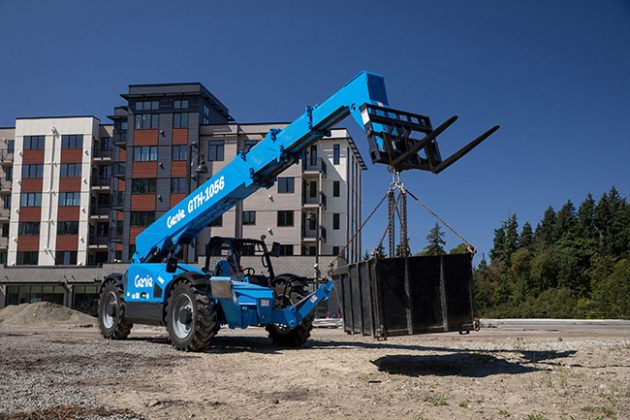
Telehandler technology trends
By Andrew Snook
Features Tech tips canada rental technology telehandler trendsWhen it comes to customers’ top priorities for what they are looking for in telehandlers, improving operator confidence, safety and productivity are at the top of their lists.
 No category of construction equipment is adding features and capabilities faster than telehandlers. As they become easier and safer to operate, they become more attractive fleet items as well.
No category of construction equipment is adding features and capabilities faster than telehandlers. As they become easier and safer to operate, they become more attractive fleet items as well. “Increasing operator confidence and productivity on jobsites are the biggest drivers with the introduction of any new technologies and features for telehandlers,” says John Boehme, senior product manager for telehandlers at JLG. “There are always jobs to be done and telehandler OEMs, including JLG, continue to look at ways that these machines can help operators do more work as well as help operators be more effective and efficient in the work they have to do.”
Genie product manager Amalija Kopac says that productivity and jobsite safety are two main drivers for the company’s telehandler customers.
“Productivity enhancements add value on the jobsite and to our customers’ businesses, and safety is something that’s always relevant and important in our industry,” she says.
Some of the enhanced safety features available for telehandlers include backup cameras, proximity alarms, boom control technologies and load stability indication (LSI) systems.
“Telehandlers equipped with a load stability indication system can aid operators by helping them to remain within the forward load capacity of the telehandler,” Boehme says. “Advancements in back-up camera technologies, like a multi-reverse camera system, can help operators see more on the backside of the machine. Giving operators more confidence when backing up increases jobsite awareness by displaying multiple views from behind the machine — left, right, and rear. Finally, advancements in boom control technology, such as remote boom control, enables operators to control the telehandler’s boom from outside the cab. This feature provides operators with improved visibility during load placement.”
Kopac says that advancements in engine technologies are improving telehandler efficiencies on jobsites.
“Today’s telehandlers are more fuel efficient and designed to meet increasingly stringent emissions requirements. A good example of this is the new Genie GTH-1056,” Kopac says. “This latest addition to the Genie telehandler family has three different powertrain options, including a 74-horsepower engine with continuously variable transmission. This lower-horsepower engine does not require diesel exhaust fluid while the CVT delivers performance on par with a 120-horsepower engine but with greater fuel efficiency.”
Boehme says digital solutions are also playing a key role in improving efficiencies for telehandlers.
“Although not specific to telehandlers, digital solutions are also expanding for use during the initial design and planning stages through finish work. These solutions are making jobsites more efficient. Some examples include BIM libraries and augmented reality apps, which can help rental companies and contractors plan for and select the right equipment for the work at hand,” he says.
Telematics
For rental houses and other telehandler owners, enhanced telematics capabilities are also a top priority.
“Telematics is certainly gaining some steam in more and more rental houses,” says Mike Peterson, telehandler product application specialist at Caterpillar. “Customers appreciate the availability of telematics and what it provides: monitoring what’s going on at a jobsite.”
In addition to logging hours and tracking the locations of the machines, additional capabilities like geofencing for keeping telehandlers in a certain geographic area are also valuable features, Peterson says.
“Telematics enable an equipment owner better visibility and control over their fleet. This is particularly important as equipment owners’ fleets grow and become more dispersed, which is where solutions like Genie Lift Connect telematics come in,” Kopac says. “Lift Connect is designed to deliver actionable data so that equipment owners have a greater understanding of how their fleet is being utilized and allows them to better plan for things like service and maintenance, or when they might need to replenish their fleet.”
“In the age of big data, the adoption and use of telematics systems in the telehandler market continues along the construction industry’s growth trajectory,” adds Boehme. “The JLG ClearSky fleet management telematics solution is available on telehandlers, providing equipment owners and operators access to critical engine and equipment operational data so they can make better decisions on their investment. Data points – including location, engine hours, usage, fuel and battery levels and maintenance schedules – are conveniently available in real-time and accessible from desktop or mobile devices. The system also monitors fault codes and other critical alerts so maintenance can be proactively managed to reduce unplanned downtime.”
Growing attachment
According to Boehme, the most popular telehandler attachments generally fall into four categories: buckets, carriages, truss booms/lift hooks and specialty attachments.
“The most recent attachment introductions have been in the “specialty” category because these tools are designed and purpose-built to meet specific jobsite applications. For example, a sheet material handler attachment is ideal for use in building construction projects, giving operators the ability to confidently lift and place a variety of materials. The attachment can be used for picking and placing sheetrock, drywall, plywood, green board and other sheet materials,” he says. “These quick coupler-mounted sheet material handler attachments can lift up to 3,000 pounds and offer a 72 inches maximum fork spread, allowing for heavy and wide materials to be delivered at height. To reduce worker fatigue, a typical sheet material handler attachment will have 100-degree fore and aft fork tilt and 180-degree side swing, which ensures accurate, convenient placement at the desired location.”
Peterson says that hydraulic fork positioning carriages have been drawing increased interest.
“Being able to move forks hydraulically from within the machine reduces the need for an operator to have a helper adjust the forks,” he says. “Every time an extra person is around a machine is a risk, plus the time it takes for the operator to adjust manually, this offers a big-time reduction.”
Peterson adds that some less common attachments have been drawing increased interest, such as a pipe grapple for picking up PVC pipes.
“We also offer a fabricated self-dumping trash hopper that is secure,” he says, adding that it offers increased safety compared to makeshift wood creations often seen on jobsites. “This gives a little more security when you’re loading trash, whereas these creations made on the jobsite made with thrown out pallets and plywood add additional risk that’s not necessary.”

Hydraulic fork positioning carriages have been drawing increased interest.
A growing market
While general construction continues to be the biggest market for telehandlers and their versatile applications, other markets include residential construction, refurbishment construction, parking garage construction and maintenance, landscaping and hardscaping, as well as agriculture.
“We also see potential for these machines to be used in opportunities with adjacent markets, such as the forestry industry, on wind and solar energy farms, as well as at above-ground mining and quarry operations,” Boehme says.
“Generally, there’s a demand for higher capacity and higher heights,” Kopac adds. “At the same time, because telehandlers are multi-purpose tools used for a variety of tasks around the jobsite, the market remains strong for small, compact telehandlers as well.”
The future
Kopac says in the future, in terms of technologies, it makes sense that we’ll continue to see more features introduced that do things like automate load charts, or more cameras that allow an operator visibility in whichever direction they’re moving.
“In terms of markets, you see newly industrialized countries starting to adopt productivity and safety tools, like a telehandler, to improve jobsite safety and productivity at height,” she adds.
While hearing about the autonomous work sites of the future where machines communicate to each other and the people that manage them can sound like some far-off concept that’s still years down the road, it’s closer than you think, Boehme says.
“Technological advancements continue to redefine expectations and experiences in nearly every aspect of the construction industry — including telehandlers. While a fully autonomous job site may be in the distant future, telehandler users are embracing moments of autonomy through their already connected devices that can solve some of the most common industry challenges, like simplifying project planning, improving fleet management and enhancing training, while driving safety and productivity gains,” he says. “Some of these technologies include augmented reality apps that can make machine selection more intuitive. AR apps can also help with machine visualization to better understand how telehandlers can be used around job sites; virtual reality programs that can assist in operator training, and building information modeling which also aids with machine visualization because models look and act as the real equipment would on the job; and telematics that can help service technicians with remote diagnostics and planning maintenance tasks.”
Print this page